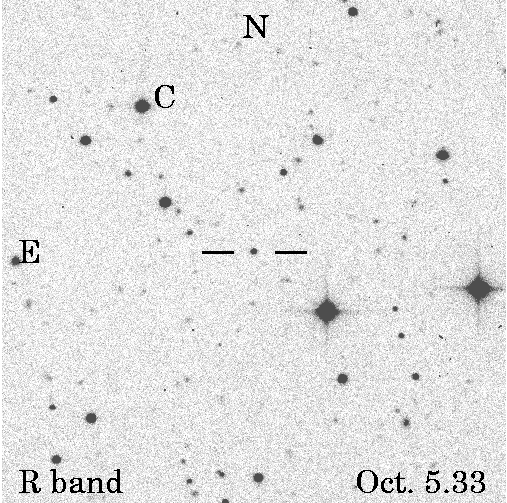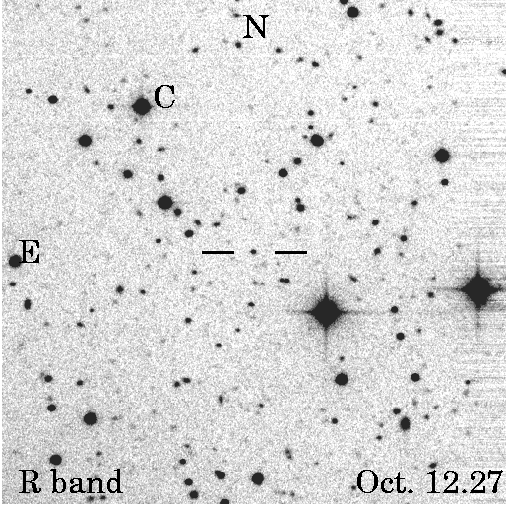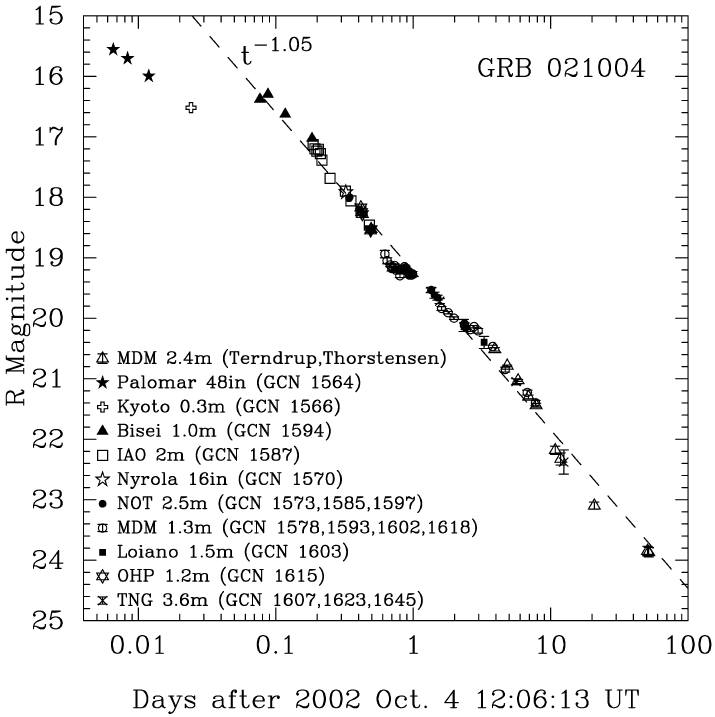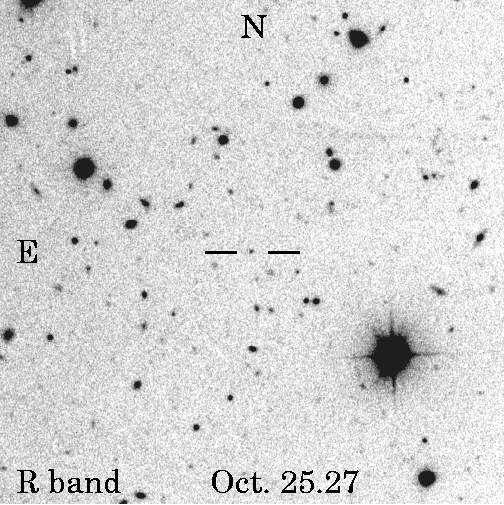|
|
|
|
|
|
|
|
GRB 021004: Optical Monitoring
MDM 1.3m (4.3 x 4.3 arcmin display)
 |
 |
| GCN Circular #1578: GRB 021004: Optical Observations |
J. P. Halpern, E. K. Armstrong, C. C. Espaillat (Columbia), J. Kemp (Joint Astronomy Centre and Columbia) report for the MDM GRB follow-up team: "We observed the optical afterglow (Fox, GCN #1564) of GRB 021004 with the MDM 1.3m in BVRI. On 2002 Oct 5 UT, we measure the following preliminary magnitudes: -------------------- UT R +/- -------------------- 03:02 19.06 0.06 03:36 19.17 0.05 04:26 19.24 0.03 04:51 19.30 0.04 05:15 19.30 0.03 05:39 19.25 0.03 06:10 19.33 0.03 06:34 19.30 0.04 06:56 19.32 0.03 07:19 19.42 0.03 07:42 19.31 0.03 08:05 19.31 0.03 08:28 19.31 0.03 08:50 19.27 0.03 09:13 19.29 0.03 09:41 19.34 0.03 10:03 19.34 0.03 10:41 19.41 0.03 11:04 19.39 0.03 11:26 19.41 0.04 11:50 19.39 0.04 -------------------- We employed the Weidinger et al. (GCN #1573) revised calibration star. These measurements are consistent with and extend the steepening light curve that they saw. The combined NOT and MDM points indicate a decay slope alpha = 1.16 +/- 0.07, but there are possible fluctuations of the type referred to by Winn et al. (GCN #1576) in our data that are contemporaneous with theirs. An updated decay curve is available at: http://www.astro.columbia.edu/~jules/021004.ps An equal number of images in each of B, V, and I were obtained, and will be analyzed subsequently." |
| GCN Circular #1593: GRB 021004: Optical Decay |
J. P. Halpern, N. Mirabal, E. K. Armstrong, C. C. Espaillat (Columbia),
J. Kemp (Joint Astronomy Centre and Columbia) report for the MDM GRB
follow-up team:
"Continued monitoring of the optical afterglow of GRB 021004 with
the MDM 1.3m yields the following measurements on 2002 Oct 6 UT:
--------------------
UT R +/-
--------------------
02:41 19.84 0.03
07:03 19.91 0.02
11:39 20.00 0.02
--------------------
Here we used the revised calibration of Henden (GCN #1583) in which
the reference star has R=15.52. Previous R magnitudes reported in
GCN #1578 would have to be decreased by 0.12 to match this reference.
The mean R-band decay between 8 and 48 hours as determined by the NOT and
MDM measurements can be described as a power law of slope -1.05, but with
highly significant deviations from a power law (Winn et al., GCN #1576)
that are robust against cross-calibration issues."
An updated decay curve will be maintained at:
http://www.astro.columbia.edu/~jules/021004.ps
|
| GCN Circular #1602: GRB 021004: Optical Decay |
N. Mirabal, E. K. Armstrong, J. P. Halpern (Columbia), and
J. Kemp (Joint Astronomy Centre and Columbia) report for the
MDM GRB follow-up team:
"Continued monitoring of the optical afterglow of GRB 021004 with
the MDM 1.3m yields the following measurements on 2002 Oct 7 UT:
--------------------
UT R +/-
--------------------
02:38 20.19 0.03
06:37 20.14 0.02
11:21 20.21 0.04
--------------------
Here we used the revised calibration of Henden (GCN #1583) in which
the reference star has R=15.52. Although the decay appears to have
slowed over the past day, it is difficult to know at this time whether
it has stopped fading, or for how long."
An updated decay curve accounting for revised calibrations of
GCN published data is at:
http://www.astro.columbia.edu/~jules/021004.ps
|
| GCN Circular #1618: GRB 021004: WC wind? |
N. Mirabal, J. P. Halpern (Columbia), R. Chornock, and A. V. Filippenko
(UC Berkeley) report:
"Continued monitoring of the optical afterglow of GRB 021004 with the
MDM 1.3m by E. K. Armstrong yields the following measurements:
----------------------------
UT R +/-
----------------------------
Oct. 8 07:05 20.48 0.03
Oct. 9 04:21 20.72 0.04
----------------------------
Here we use the calibration of Henden (GCN #1583) in which the reference star
has R=15.52. An updated decay curve accounting for revised calibrations of
GCN reported data is at:
http://www.astro.columbia.edu/~jules/021004.ps
Further examination of the optical spectrum reported by Chornock and Filippenko
(GCN #1605) yields the following features in the highest redshift system
("em" refers to emission, "bl" denotes a broad blend of z=2.323 and 2.318):
-------------------------------------------
Line Rest wavelength z
-------------------------------------------
Ly beta 1025.7 2.323 bl
2.291
Ly alpha 1215.7 2.328 em
2.319 bl
2.295
Si IV 1393.8,1402.8 2.323
2.318
2.293
C IV 1548.2,1550.8 2.323
2.317
2.293
Al II 1670.8 2.328
-------------------------------------------
This spectrum was taken in five 1200 s exposures from Oct 8 10:14-14:05 UT.
In view of the 6 Angstrom resolution of this spectrum, we consider that the
lowest redshift absorber of the three is a blend of two of the four systems that
were seen by Salamanca et al. (GCN #1611) in higher resolution data. Also, we
detect one absorption line (Al II 1670) at the same redshift as the Ly alpha
emission, z=2.328, which we therefore designate the redshift of the host galaxy.
The detection of this lone low-ionization absorber is plausible because of its large
oscillator strength, f=1.83. Thus, all of the high-ionization absorbers are
blueshifted from the host redshift, by up to 3,200 km/s.
The decay curve shows significant deviations from a power law, which might be
understood in terms of inhomogeneities in the ambient medium in which the afterglow
expands. In view of the revised redshift of 2.328 and the multiple blueshifted
H, C IV, and Si IV absorption lines, we hypothesize that the velocity span of
3,200 km/s in these components is indicative of a clumpy wind from a massive hot star
progenitor, such as a Wolf-Rayet star. This would avoid the difficulties of scenarios
involving supernova ejecta or cosmic clustering, as explained in GCN #1611. The absence
of nitrogen lines and the presence of Ly alpha and Si IV weaker than C IV is consistent
with a WC star, in which the bulk of the wind is approximately equal parts He and C.
We assume a typical mass-loss rate of 10(-5) Msun/yr and a wind terminal velocity
of 3,000 km/s. Following Chevalier & Li (2000, ApJ, 536, 195), the predicted radius
r_s of a spherical adiabatic blast wave in such a stellar wind at an observed time of
1 day is 3.5x10(17) cm for an isotropic energy of 5.6x10(52) erg (Malesani et al.,
GCN #1611), or 3.5x10(16) cm if there is a beaming correction of 1/100 to the energy.
Chosing the larger value of r_s, the column density of C in the wind is at least
3.6x10(15) cm(-2) between the shock and the deceleration radius of the wind, which
is of order 5x10(17) cm or greater (Ramirez-Ruiz et al. 2001, MNRAS, 327, 829). This
would be enough to account for the observed absorption at high velocities. We note that
for a typical nu(-1) broad-band spectrum, C IV ions in the wind would absorb in the line
before being photoionized. Detailed photoionization models are needed to predict the
evolution of the column densities. A consequence of this model is that the high-velocity
components of C IV should decline after being photoionized, or as the shock overruns the
wind in several days. Continued spectroscopic monitoring of this bright afterglow is
urged in order to search for this definitive signature of the massive star progenitor of
GRBs. Changes in the decay curve could also result when the afterglow reaches the
termination of the stellar wind with the ISM."
|

|
MDM 2.4m (2.3 x 2.3 arcmin display)
 |
|
Nestor Mirabal abulafia@astro.columbia.edu |
Jules Halpern jules@astro.columbia.edu |
Jonathan Kemp j.kemp@jach.hawaii.edu |
|
Eve Armstrong eka5@columbia.edu |
Catherine Espaillat cce10@columbia.edu |
Maritza Tavarez tavarez@draco.astro.lsa.umich.edu |
|
Don Terndrup terndrup@astronomy.ohio-state.edu |
John Thorstensen thorsten@partita.dartmouth.edu |
| Columbia University and MDM Observatory |
